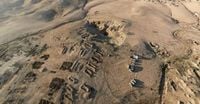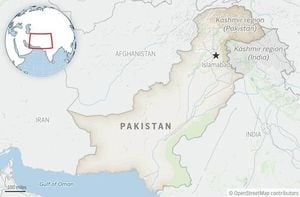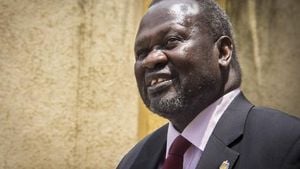In a somber but determined effort to confront the legacy of violence left by the Islamic State, Iraqi officials have begun excavating what is believed to be one of the largest mass graves in the country’s modern history. The operation, centered at a notorious sinkhole in al-Khafsa, just south of Mosul, marks a pivotal moment for families who have waited years for answers about the fate of their loved ones.
According to the state-run Iraqi News Agency, the excavation began on August 9, 2025, with a coalition of local authorities, forensic investigators, Iraq’s Martyrs’ Foundation, and the directorate of mass graves working together at the site. The government’s resolve was further underscored on August 17, when spokesman Bassem al-Awadi publicly pledged to support “all technical and legal efforts to identify the victims and ensure their relatives receive the help needed and all their rights.”
The al-Khasfa mass grave sits in the northern Nineveh province, a region that bore the brunt of Islamic State’s (IS) brutal rule from 2014 to 2017. The site itself is infamous among locals—a gaping geological scar that, for years, has been whispered about as a dumping ground for victims of IS atrocities. Now, those whispers are being confronted with the hard work of forensic science and the determination of families seeking closure.
Abdul Qader Al Dakhil, governor of Nineveh, estimated that the grave could contain the remains of up to 20,000 people. “The Al-Khasfa mass grave in the northern Nineveh province contains the remains of thousands of innocent Iraqi victims,” al-Awadi stated, echoing the gravity of the task ahead. While these numbers are based on witness accounts and unofficial testimonies, the sheer scale of the operation has stunned even seasoned investigators.
Ahmad Qusay al-Asady, head of the Martyrs Foundation’s mass graves excavation department, described the complexity of the site in an interview with The Associated Press. “Khasfa is a very complicated site,” he explained. The hazards are many: the sinkhole is filled with sulfur water, and unexploded ordnance from past battles still lurks beneath the surface. For now, the excavation is limited to gathering visible human remains and collecting surface evidence, with the ultimate goal of a full exhumation once international support and specialized expertise are secured.
The process is methodical and cautious. After the initial 15-day phase, teams will focus on building a database and collecting DNA samples from families of suspected victims. Laboratory processing and the creation of a comprehensive DNA database are essential first steps to ensure proper identification. Only after these foundations are laid will full-scale exhumation proceed—a process that will require patience, technical precision, and, above all, respect for the dead and their families.
For many Iraqis, the excavation is not just about uncovering the past; it’s about reclaiming dignity and providing long-awaited answers. Rabah Nouri Attiyah, a lawyer who has worked on more than 70 cases of missing people in Nineveh, told the AP that information he obtained from the Martyrs Foundation and Iraqi courts points to Khasfa as “the largest mass grave in modern Iraqi history.” However, al-Asady offered a note of caution, saying investigators “cannot confirm yet if it is the largest mass grave” to be found in Iraq, “but according to the size of the space, we estimate it to be one of the largest.”
The identities of those buried at Khasfa are gradually coming into focus. Attiyah estimated that roughly 70% of the human remains belong to Iraqi army and police personnel, with the remainder including Yazidis from Sinjar and Shiite victims from Tal Afar. These were the groups most heavily targeted by IS during its reign of terror. “Many of them were decapitated,” Attiyah recounted, based on interviews with eyewitnesses who saw IS fighters bring people to the site by bus and execute them.
For Attiyah, the mission is personal. His own uncle and cousin, both police officers, were killed by IS. He is among the many Iraqis hoping to identify and recover the remains of loved ones who vanished during those dark years. The testimonies collected from survivors and witnesses, as well as findings from other mass graves in Nineveh, suggest that the Khasfa site holds the remains of a cross-section of IS’s victims: military, police, Yazidis, and Shiite civilians.
The scale of the violence perpetrated by IS is difficult to comprehend. At its peak, the group controlled territory in Iraq and Syria roughly half the size of the United Kingdom. Its reign was marked by extreme brutality—beheadings of civilians, the systematic enslavement and rape of Yazidi women, and mass executions of anyone perceived as a threat to its authority. The group’s defeat in Iraq came in July 2017 when Iraqi forces retook Mosul, IS’s largest stronghold. Three months later, Kurdish forces captured Raqqa in Syria, and by March 2019, the last pocket of IS-held territory in Baghouz, eastern Syria, fell to U.S.-backed Syrian Democratic Forces.
Yet, the scars left by IS have proven harder to erase than its territorial gains. Scores of mass graves have been discovered across Iraq and Syria, each one telling a story of loss, survival, and the enduring hope for justice. The Khasfa site, with its estimated thousands—perhaps as many as 20,000—buried victims, stands out as a grim symbol of the conflict’s human cost.
Officials say that, for now, the excavation is just the beginning. The government has promised to support all efforts to identify victims and ensure that families receive the help and rights they deserve. This commitment is more than bureaucratic; it is a recognition of the suffering endured by countless Iraqi families and a pledge to restore a measure of dignity to those who were denied it in life.
As the work at Khasfa continues, the world is reminded of the importance of memory, justice, and the painstaking process of healing after atrocity. For the families of the missing, each bone recovered and each name restored is a step toward closure—a small but vital act of defiance against the forces that sought to erase them.
The excavation at al-Khasfa is a stark reminder of the horrors of the recent past, but also a testament to Iraq’s determination to confront its wounds and honor its lost. As the dust settles over the sinkhole south of Mosul, the country moves—slowly, painfully—toward reckoning, remembrance, and, perhaps, reconciliation.





